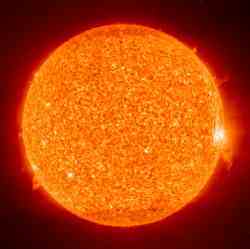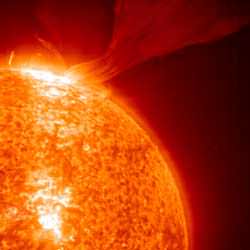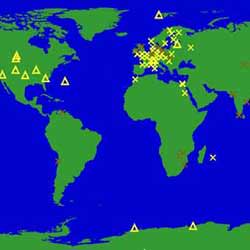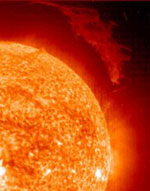
The Sun. Image credit: NASA/ESA Click to enlarge
NASA researchers have developed a technique that allows them to look right through the Sun to see what’s happening on the other side. The Solar and Heliospheric Observatory (SOHO) can trace the sound waves caused by active regions on the opposite side of the Sun. This technique allows the researchers to be more prepared when large sunspots rotate around to face the Earth, and better predict active space weather.
NASA researchers using the Solar and Heliospheric Observatory (SOHO) spacecraft have developed a method of seeing through the sun to the star’s far side. The sun’s far side faces away from the Earth, so it is not directly observable by traditional techniques.
“This new method allows more reliable advance warning of magnetic storms brewing on the far side that could rotate with the sun and threaten the Earth,” said NASA-supported scientist Phil Scherrer of Stanford University, Stanford, Calif.
Magnetic storms resulting from violent solar activity disrupt satellites, radio communications, power grids and other technological systems on Earth. Advance warning can help planners prepare for operational disruptions. The sun rotates once every 27 days, as seen from Earth, and this means the evolution of active regions on the far side of the sun previously has not been detectable.
Many of these storms originate in groups of sunspots, or active regions – areas with high concentration of magnetic fields. Active regions situated on the near side of the sun, the one facing the Earth, can be observed directly. However, traditional methods provided no information about active regions developing on the other side of the sun. Knowing whether there are large active regions on the opposite side of the sun may greatly improve forecast of potential magnetic storms.
The new observation method uses SOHO’s Michelson Doppler Imager (MDI) instrument to trace sound waves reverberating through the sun to build a picture of the far side.
The sun is filled with many kinds of sound waves caused by the convective (boiling) motion of gas in its surface layers. The far side imaging method compares the sound waves that emanate from each small region on the far side with what was expected to arrive at that small region from waves that originated on the front side. An active region reveals itself because its strong magnetic fields speed up the sound waves. The difference becomes evident when sound waves originating from the front side and from the back side get out of step with one another.
“The original far-side imaging method only allowed us to see the central regions, about one-quarter to one-third of its total area,” Scherrer said. “The new method allows us to see the entire far side, including the poles.” Scherrer started an effort to use the new method to create full far-side images from archived MDI data collected since 1996. The project was completed in December 2005.
Douglas Biesecker of the National Oceanic and Atmospheric Administration’s Space Environment Center, Boulder, Colo., said, “With the new far side photo album going back to 1996, we can discover identifying characteristics of active regions. This will improve our ability to distinguish real active regions.”
SOHO is a cooperative project between the European Space Agency and NASA. For SOHO information and images on the Web, visit:
www.nasa.gov/vision/universe/solarsystem/soho_xray.html
Original Source: NASA News Release



